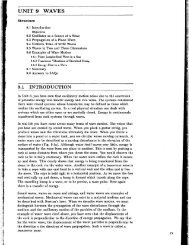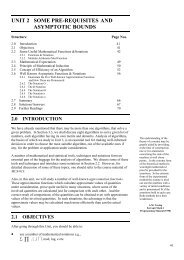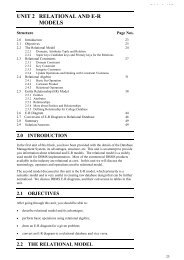unit 1 differential calculus - IGNOU
unit 1 differential calculus - IGNOU
unit 1 differential calculus - IGNOU
You also want an ePaper? Increase the reach of your titles
YUMPU automatically turns print PDFs into web optimized ePapers that Google loves.
The role that the graph of a function plays in the study of the function will<br />
become clear as we proceed further. In the meantime let us consider some<br />
more examples of functions and their graphs.<br />
A Constant Function<br />
A simple example of a function is a constant function. A constant<br />
function sends all the elements of the domain to just one element of<br />
the co-domain.<br />
For example, let f : R → R be defined by f (x) = 1.<br />
Alternatively, we may write<br />
f : x → 1 for all x ∈ R<br />
The graph of f is as shown in Figure 1.3.<br />
1<br />
0<br />
y<br />
f (x) = 1<br />
Figure 1.3<br />
It is the line y = 1.<br />
In general, the graph of a constant function y : x → c is a straight line<br />
which is parallel to the x-axis at a distance of c <strong>unit</strong>s from it.<br />
The Identity Function<br />
Another simple but important example of a function is a function<br />
which sends every element of the domain to itself.<br />
Let X by any non-empty set, and f be the function of X defined by<br />
setting f (x) = x, for all x ∈ X.<br />
This function is known as the identity function on X and is denoted<br />
by IX.<br />
The graph of IR, the identity function of R, is shown in Figure 1.4. It is<br />
the line y = x.<br />
0<br />
y<br />
Figure 1.4<br />
y = x<br />
x<br />
x<br />
Differential Calculus<br />
11
















